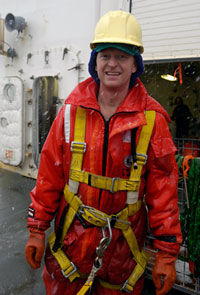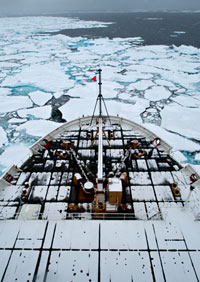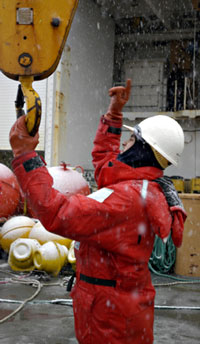|
|
 |
 |
 |
| Jim Johnson celebrates successfully redeploying the two University of Washington moorings. |
Click
to enlarge
|
 |
 |
| Snow collects on the foc'sle as the Healy steams northward. |
| Click
to enlarge |
 |
 |
| Boatswain's mate Darrell Bresnahan guides the crane hook up after the mooring deployment. |
| Click
to enlarge |
Daily Update
Calendar
Dispatch 08 - September 17, 2003
By C. A. Linder
Weather conditions: Overcast skies, snow flurries,
15 kt winds, 1-2 ft seas, air temperature 30°F
Farthest North
Our bow is pointed to the northeast, and we're headed to our farthest
north position on the cruise, roughly 74.5°N. Even though it seems
like we're on the edge of the earth, that's still over 1,000 miles
from the North Pole. Snow has been falling intermittently all day
today, and ice has been building up on the metal railings. That didn't
stop our mooring team from putting in an impressive performance, though.
Jim Johnson's second mooring released immediately when he sent the
command, to everyone's relief. By midafternoon Jim had also supervised
the redeployment of both of the University of Washington moorings.
Now he's working hard on getting a year's worth of data off of the
instruments he has pulled out of the frigid depths.
I'm getting lots of excellent questions from our
junior Arctic explorers! In the coming dispatches I will be grouping
related questions together, so don't worry if I don't answer your
question right away - I may be saving it for later. These questions
come from Mrs. Cadwell's 5th grade class at Varnum Brook Elementary
School.
Question from Josh: Here in Pepperell we see 12 hours and 23 minutes of daylight; losing about 4 minutes per day as the seasons change. What is the sun doing up there?
Answer: Josh, I haven't seen the sun since this cruise
started! By my calculations, though, sunrise is at 8:16AM and sunset
is at 9:38PM. That's 13 hours and 22 minutes of daylight, just a little
more than what you have there in Pepperell. Since we are so far north,
daylight is slipping away at a much faster rate -- 11 minutes a day
compared to your 4 minutes. On December 21st (also known as the Winter
Solstice), if you are standing on or north of the Arctic Circle (66.5°N),
the sun will not rise for the entire day. At the North Pole, the situation is even more bizarre - essentially there is only one "day" the entire year. The sun
sets on December 21st and rises on June 21st. During the winter months the sun never breaks the horizon, and during the summer months the sun never sets. That's where the expression "Land of the Midnight Sun" comes from.
A related question from Taylor: If the circumference of the earth is smaller where you are, is a day still 24 hours or does time travel faster or what?
Answer: The circumference of the earth is indeed
smaller at our extreme latitude, but it still takes the same amount
of time for the earth to complete one revolution, regardless of your
distance from the equator. Time doesn't pass any faster here in the
Arctic; in fact it feels like it passes very slowly when you're at
sea!
Here are a couple of questions about staying warm - both outside the
ship and inside.
Tim from Varnum Brook Elementary asks this question: What do you wear? From the pictures everyone seems pretty bundled.
Answer: The bulky orange suits that you
see people wearing are called "Mustang suits". They keep
us toasty warm even when the snow is coming down and the wind is blowing
hard. The most important reason we wear them, though, is in case someone
is knocked overboard while working on deck. The water is so cold that
you can go into shock almost immediately after falling in. The mustang
suit provides flotation that will keep your head above water in the
event you are unconscious. The bright orange color also ensures that
you will be seen and rescued quickly.
Jorden from Morse Pond School asks: Does the boat
have heat?
Answer: Yes, Jorden, the ship is heated on the inside
to a comfortable 70°F. Of course it feels even warmer if you're
wearing your mustang suit!
Here are some additional questions from Mrs. Werner's 6th
grade class:
Alessio asks: Approximately
how long will it take to get to your final destination?
Answer: We plan on arriving in Nome, Alaska, on
October 19th. Since Nome, like Barrow, does not have a pier that the
Healy can dock at, we will be shuttled from the icebreaker
to the airport via helicopter.
Matt wants to know: About the
jelly fish - how much did it weigh?
I decided to ask Christina Courcier about the jellyfish since she actually held it in her hands - here's what she told me:
"Hi Matt - the jellyfish
weighed about 2-3 pounds. The photo you saw only shows some of it,
the tentacles were darker in color (brick-red) and stuck on our water
sampling bottles. They seemed as though they could have been almost
ten feet long before they became tangled on our instrument. The center
of the jellyfish I was holding was very firm, but also soft, sort
of like tough jello.
PS- I went to Morse Pond School in 1976!"
Late tonight we will begin a long line of CTD casts heading south
from our farthest north point. Principal Investigators Rebecca Woodgate
and Bob Pickart have already begun to analyze the CTD data that we
have collected in Barrow Canyon and were struck by how different the
water conditions are compared to last year's cruise. They will be
working hard over the course of the cruise to formulate some ideas
about what has caused these changes.
 Previous
Dispatch Next Dispatch Previous
Dispatch Next Dispatch

Back to
Calendar
|
|




